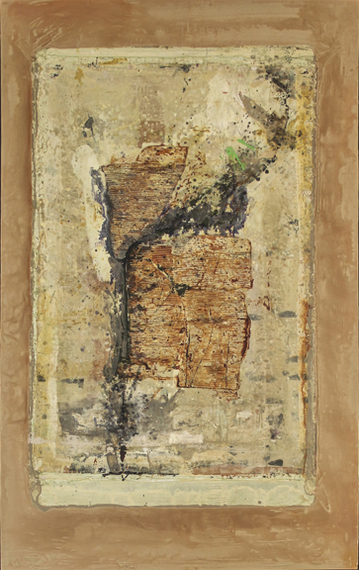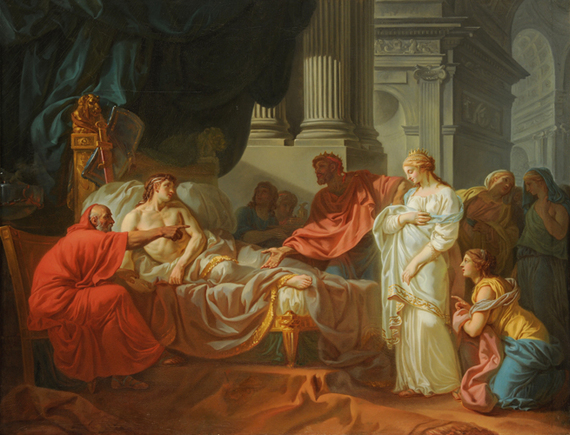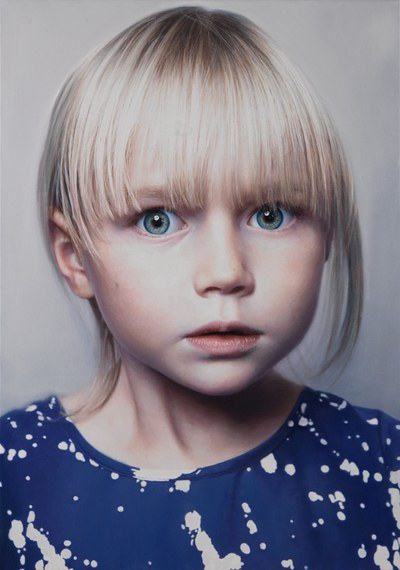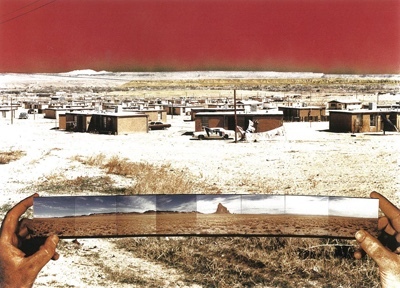MARTIN FACEY, Ink Ginkgo, 2013, Acrylic, mixed media, fabric on panel, 68 x 42 inches
Martin Facey was long known as a colorist, straddling figuration and abstraction in the realization of large, intricately mapped paintings; the influence of Richard Diebenkorn - for whom Facey was long a studio assistant - was apparent, but Facey's far more baroque sensibility pushed him to yet denser composition and yet more vivid coloration. Years later, he has re-emerged with a series of large and small works that build on the opposite end of Diebenkorn's legacy. Indeed, color is suppressed in these new pieces in favor of dry, earthy tones that fairly crackle with Autumn and the desert, and it is in their brittle networks of lines and branches that they at all recall the older artist's own structural elaborations. The semblance to branches is no coincidence; tree limbs and other plants, some seemingly pressed into the dense surfaces of the paintings as if between the pages of a book, provide Facey with the centralized, almost iconic, imagery around which he builds the rest of each painting. The floral apparitions and the yet more weathered material that surrounds them, including fabric and paper, combine into powerfully sensuous carpets, pages or banners onto which have been inscribed what seem like ruminations on natural cycles. What remains from Facey's earlier work is his unusual ability to activate his surfaces with quasi-appliqué patterns which have nothing to do with the basic composition but serve to enrich its contents and their tonalities. Despite their weathered appearance and their reliance on mineral and vegetable tonalities, these gritty figures-and-grounds grip the eye and do not let it go. No longer jewels, Facey's paintings are now forests. (Paul Mahder, 222 Healdsburg Ave., Healdsburg CA; thru December. www.paulmahdergallery.com)
JACQUES-LOUIS DAVID, Erasistratus Discovers the Cause of Antiochus's Disease, 1774, Oil on canvas, 47¼ x 61 inches, École des Beaux Arts, Paris, Courtesy American Federation of Arts
We cite the Academy as a dominant force - usually negative - in the art world, but what is, or was, the Academy really? The École des Beaux-Arts, founded in the mid-17th century under (and with the blessings of) Louis XIV, began as a means of disseminating a standard for artistic principles and methods that superseded the calcifying guild system. In other words, the Academy was a reformist institution. Two centuries later, it had become exactly the opposite, and, under the onslaught of a very different set of artistic values, its pre-eminence dwindled almost to nothing by World War I. Those principles and methods survive, to be sure, as does the school in some form; but the pedagogical framework that enforced them has become an historical curiosity - even as the achievements of so many of the students and teachers who passed through the École embed themselves at the core of Western art history. As well they should: they were taking formal and conceptual ideals inherited from the Renaissance (the Florentine Accademia was the École's direct forerunner) and Greco-Roman antiquity and making them speak for their own eras, and the best of them, like the best composers and poets, are still able to make them speak for ours. "Gods & Heroes" documents, exhaustingly yet thrillingly, not just the giants and also-rans who made the École des Beaux-Arts the historical colossus it is but the things they had to do, or teach, in the school itself. Indeed, the most engaging portions of "Gods & Heroes" are not the portraits and masterpieces that account for the emergence and triumph of the École, but the alignments of artifacts and studies and competition pieces that reveal how the school worked - what exercises it dictated, what themes it promulgated, what it considered proper subject matter, and so forth. "Gods & Heroes" makes the basics clear enough: everything centered around the ideal human (especially male) body, and the best (often only) subjects to paint were historical, biblical, or mythological subjects that would reify the moral education and social perception of the educated populace. The show also clarifies that the École, despite its debt to the crown, was a hotbed of republican sentiment long before the Revolution. Technically, the show emphasizes that drawing was not just considered the precursor of painting, but its fundament, and that line, contour, and shade were, if anything, more important than tone and modeling. While the show does stress the importance of working from statuary and the live nude, it does not stress that of copying - although an extensive print and drawing collection demonstrates how artists and artworks not directly available to Academicians were understood and studied. Yet more intriguing are the groupings of subjects, not least exercise subjects such as facial expressions, but also competition themes, including less exalted subjects such as landscape and portraiture. These cover mostly the 19th century, the moment of the École's apotheosis and gradual decline, when it dictated artistic taste around the Western world and allowed its rigor to descend into rigidity. "Gods & Heroes" - whose every work comes from the collection of the École itself - is filled with these comparative episodes, jumping from chronology to analysis to anecdote with a surprising nimbleness. (Albuquerque Museum, 2000 Mountain Rd. NW, Albuquerque; thru Jan. 4. www.albuquerquemuseum.org Travels to Patty & Jay Baker Naples Museum of Art, Naples FL, Feb. 19-May 17, 2015, and Portland [OR] Museum of Art, June 13-Sept. 13, 2015.)
GOTTFRIED HELNWEIN, Head of a Child (Ruth), 2014, Oil and acrylic on canvas, 48 x 34 inches
Gottfried Helnwein has earned his reputation as a Gothic hyper-realist whose cinematic style - cinematic in scale, in appearance, and in subject - seeks to challenge institutional as well as individual presuppositions. But that reputation flattens a complex artistic personality into a kind of anti-entertainer, and Helnwein is far more than the sum of his spectacles. In a show of seemingly very quiet subjects, the Austrian-born, Los Angeles- and Ireland-based painter examines the way we read, and read into, others' expressions. In this case, the "others" are either inanimate objects - several heads of toys (all Disney characters) - or children. Both children and toys wear exaggerated expressions, but expressions that do not seem unnatural to them; if anything, they seem tempered, the toys' by the crepuscular light Helnwein throws around them and the kids' by the odd lack of hyperbole which such pre-teens - especially girls - are normally wont to display. These girls seem truly apprehensive, doubtful, suspicious, frightened, disbelieving, even slightly shell-shocked. Yet Helnwein does not exploit their seeming fragility so much as commute it to us; the way he paints these quietly fearful children provokes not our sympathy but our empathy. We take a more doting view of the several girls' faces with their eyes closed (two of them in the dark), but amidst their wide-eyed sisters, the sleep of these innocents also seems fleeting. Next to these grimly tender visages, the several depictions of young boys theatrically got up in bandages and holding rifles or watching television do seem as histrionic as Helnwein's reputation would invoke - although they are some of the subtler, more disturbing images to address school shootings and the general level of gun violence in America. And the world. (Modernism, 685 Market St., S. Francisco; thru Jan. 10. www.modernisminc.com)
PATRICK NAGATANI, "Bida Hi"/Opposite Views, Northeast-Navajo Tract Homes and Uranium Tailings Southwest-Shiprock, New Mexico, 1990, Chromogenic print, Ilfocolor Deluxe, 27¾ x 35¾ inches
SITE Santa Fe has reformulated its 20-year-old Biennial program as a survey focusing on the Western Hemisphere - and, to judge from this first foray up and down the Trans-Continental Highway, focusing on art whose polemical content drives its aesthetic(s). The breadth of the 45-artist-strong "Unsettled Landscapes", the at-least-relative consistency of its conceptual language, and the articulate cleverness with which most of the artists project the urgency of their messages, proves fatiguing but ultimately compelling; just as the visitor despairs of reading one more elaborate scenario illuminating a collection of (normally photographic) images, that scenario proves to be curious, informative, even gripping, and the images it accompanies charming, even wryly innocent, like postcards containing a private joke to which you are being made privy. The expected sociopolitical bombast is well-represented (and, indeed, well-presented), but it is substantially outweighed by subtler, more intricate and even contemplative presentations, to the point where "Unsettled Landscapes" takes on a meditative quality, well removed from the hectoring pedantry and/or gratuitous spectacle that has so often burdened such engagé conceptual practice over the last two decades. Part of this toning-down results from the inclusion of any number of veteran, even first-generation conceptualists, artists - including "straight" photographers and videastes as well as notationalists - such as Luis Camnitzer, Agnes Denes, Juan Downey, Anna Bella Geiger, Frank Gohlke, Leandro Katz, Patrick Nagatani, and Allan Sekula who proposed tones and formats for this kind of artistic discourse forty or more years ago. (Indeed, in several cases the works themselves date back several decades.) And, in a rare concession to pure opticality, the luminous monochrome paintings Florence Miller Pierce painted in the last decade of her long life are included as a kind of perceptual touchstone. Until her passing in 2007 Pierce was a touchstone herself, the last surviving member of the northern New Mexico group of Transcendentalist painters, and including her in "Unsettled Landscapes" helps determine the "local" axis in the show's approach. The "global" axis is the stronger, however, as the show abounds with artists from Latin and Caribbean America who have made New York or Europe their home, or, conversely, European artists who have immigrated to the Americas and have made their adopted hemisphere their subject. (There are no artists of Asian background included, but there are two First Nation artists, the Cape Dorset-based Shuvinai Ashoona and Onotaq Mikkigak, represented by expansively drawn landscape renditions.) The emphasis is not on the exotic nature of the artists, however, but on the frisson, exotic and familiar, the artists have found in the space around them - a space at once populated to a fault, even subdued, and lonely and vertiginous in its vastness. (SITE Santa Fe, 1606 Paseo de Peralta, S. Fe; thru Jan. 11. www.sitesantafe.org)



